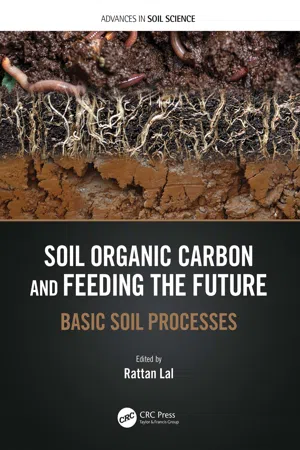
Soil Organic Carbon and Feeding the Future
Basic Soil Processes
Rattan Lal, Rattan Lal
- 324 pages
- English
- ePUB (mobile friendly)
- Available on iOS & Android
Soil Organic Carbon and Feeding the Future
Basic Soil Processes
Rattan Lal, Rattan Lal
About This Book
Soil organic matter (SOM) is a highly reactive constituent of the soil matrix because of its large surface area, high ion exchange capacity, enormous affinity for water due to hygroscopicity, and capacity to form organo-mineral complexes. It is an important source and sink of atmospheric CO2 and other greenhouse gases depending on climate, land use, soil and crop management, and a wide range of abiotic and biotic factors, including the human dimensions of socioeconomic and political factors. Agroecosystems are among important controls of the global carbon cycle with a strong impact on anthropogenic or abrupt climate change.
This volume of Advances in Soil Sciences explains pedological processes set-in-motion by increases in SOM content of depleted and degraded soils. It discusses the relationship between SOM content and critical soil quality parameters including aggregation, water retention and transport, aeration and gaseous exchange, and chemical composition of soil air. The book identifies policy options needed to translate science into action for making sustainable management of SOM as a strategy for adaptation to and mitigation of climate change.
Features:
- Relates soil organic matter stock to soil processes, climate parameters, vegetation, landscape attributes
- Establishes relationships between soil organic matter and land use, species, and climate
- Identifies land use systems for protecting and restoring soil organic matter stock
- Links soil organic matter stock with the global carbon cycle for mitigation of climate change
Part of the Advances in Soil Sciences series, this volume will appeal to agricultural, environmental, and soil scientists demonstrating the link between soil organic matter stock and provisioning of critical ecosystem services for nature and humans.
Frequently asked questions
Information
1 Is There Evidence for Significant Tillage-Induced Soil Organic C Sequestration below the Plow Layer?
CONTENTS
- Abbreviations
- 1.1 Background
- 1.2 Soil Organic Carbon in Conventional Tillage and No-Tillage Systems with Depth
- 1.3 Review of Surface-Soil Effects with No Tillage
- 1.4 Soil Organic Carbon across Tillage Studies
- 1.5 Conclusions
- References
Abbreviations
- NT
- no tillage
- SOC
- soil organic carbon
1.1 Background
Table of contents
- Cover
- Half Title
- Series Page
- Title Page
- Copyright Page
- Table of Contents
- Foreword
- Editor
- Contributors
- Chapter 1 Is There Evidence For Significant Tillage-Induced Soil Organic C Sequestration below the Plow Layer?
- Chapter 2 Managing Soil Organic Carbon for Climate Change Mitigation and Food Security
- Chapter 3 Soil Management, Organic Matter, and Human Nutrition
- Chapter 4 Building Bridges between Natural Nutrient Sources and Fertilizers for Soil Health and Sustainable Food Security
- Chapter 5 Soil Organic Matter and Nutrient Availability
- Chapter 6 Soil Organic Matter and Microorganisms in Management Systems for Food and Feedstock Production
- Chapter 7 Carbon Sequestration in Productive Land Use Systems in the Peruvian Amazon
- Chapter 8 Soil Organic Matter stocks and content—Critical Policy Issues?
- Chapter 9 Modeling Soil Organic Carbon: Implications for Soil Organic Matter Management in the Indian Himalayan Region
- Chapter 10 Managing Soil Organic Matter under Dryland Farming Systems for Climate Change Adaptation and Sustaining Agriculture Productivity
- Chapter 11 Managing Soil Organic Matter for Alleviating Drought Stress in Dryland Farming in North American Great Plains
- Chapter 12 Advances in Soil Health
- Chapter 13 Soil Organic Carbon Sequestration and Turnover in Semi-Arid Tropics and Subtropics in Relation to Agronomic Yield and Sustainability
- Index